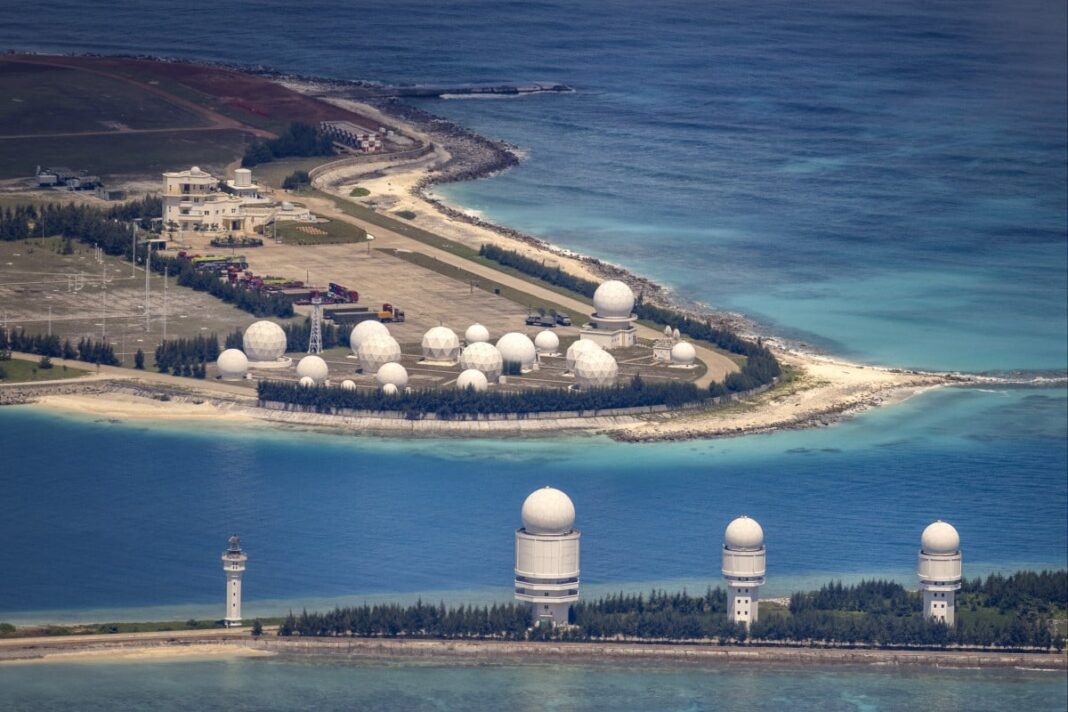China is engaged in militarisation of around 3,000 hectares of reclaimed land in the South China Sea. This includes bases on artificial islands. These bases lie within Manila’s exclusive economic zone (EEZ). According to a senior Philippine Navy official. Analysts say this development poses a significant strategic challenge to the Philippines. As it lacks the military capability to counter China’s expansion.
China’s Expansion in the South China Sea
China has built military bases on several reefs in the South China Sea. Including Gaven Reef, Zhubi Reef, and Fiery Cross Reef, which are outside the Philippines’ EEZ. However, bases on Mischief Reef and Johnson South Reef are within the EEZ. Navy spokesman Commodore Roy Trinidad detailed that these bases are equipped with airstrips, seaports, fuel depots, and resting facilities for troops. This allows China to easily position warships and aircraft in the West Philippine Sea. Which is part of the South China Sea within the Philippines’ EEZ.
Trinidad explained that the bases provide China with a strategic advantage. By allowing its forces to operate more efficiently and remain in the region longer. Without these bases, Chinese vessels would have to travel over 600 nautical miles from mainland China. This will limit their operational capabilities.
Political and Military Implications
Abdul Rahman Yaacob, a research fellow at the Lowy Institute, stated that China’s fortification of these bases reinforces its territorial claims in the South China Sea. Militarily, these bases project China’s power across the region and challenge the claims of other nations. Don McLain Gill, a geopolitical analyst, argued that the goal of China’s militarisation is to deter other forces. Including Western powers, from entering the disputed waterways.
Gill noted that it would be difficult for the Philippines to challenge China’s activities of militarisation. By forcing Manila to rely on diplomatic and legal measures. He suggested that the Philippines raise environmental concerns and portray China as expansionist to apply pressure on Beijing.
Legal and Diplomatic Measures
One potential solution is the Maritime Zone Act, which passed in Congress on July 17. This law defines the Philippines’ maritime zones and rights. It follows the United Nations Convention on the Law of the Sea (UNCLOS). In 2016, a UN court ruling based on UNCLOS supported the Philippines’ claims in the South China Sea, but China rejected the decision.
Gill said that even if the act becomes law, it can’t force China to leave its bases. The focus should be on stopping China’s further expansion. Legal expert Aldrin Alba explained that the bill would give the Philippines a legal basis to exercise its rights in the sea. This would also help the Philippines get international support.
Building Alliances and Regional Cooperation
To counter China, the Philippines has strengthened security ties with countries like Canada, France, Japan, and New Zealand. A Reciprocal Access Agreement (RAA) with Japan allows them to train together and help each other during natural disasters. The Philippines also joined a two-day “maritime cooperative activity” with the United States, Canada, and Australia to support freedom of navigation and overflight in the South China Sea.
However, Gill doubts these exercises will lead to directly confronting China. He believes that the recent agreement between Vietnam and the Philippines to hold joint maritime drills might be more important. Both countries have territorial claims that overlap with China’s. Working together could build trust and improve regional cooperation.
Yaacob pointed out that the Philippines aims to anchor external powers in Southeast Asia to counterbalance China. As ASEAN (the Association of Southeast Asian Nations) is unable to support the Philippines in its disputes with China.
Way Forward
The Philippines faces significant challenges in countering China’s militarization in the South China Sea. While military confrontation is not feasible, Manila must rely on diplomatic, legal, and regional cooperation to address China’s expansionist activities. Building alliances and enhancing regional cooperation are crucial for maintaining the status quo. And preventing further Militarisation in the South China Sea.

